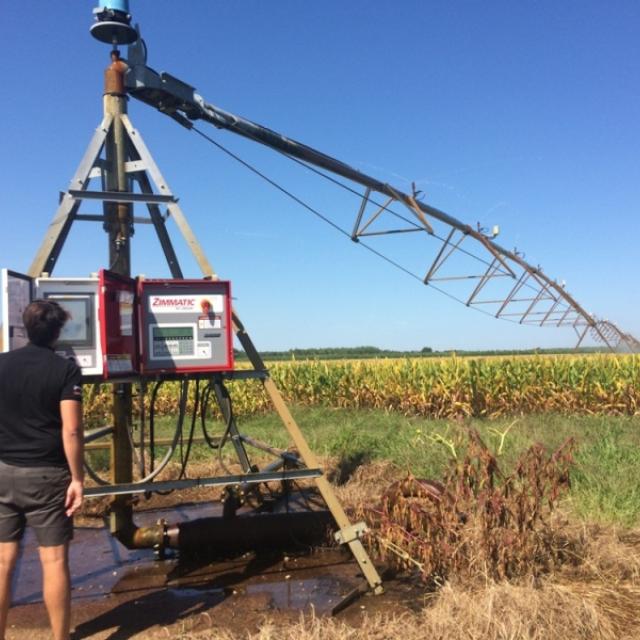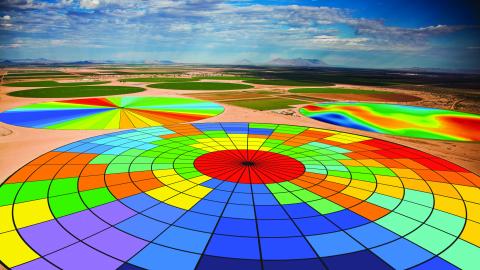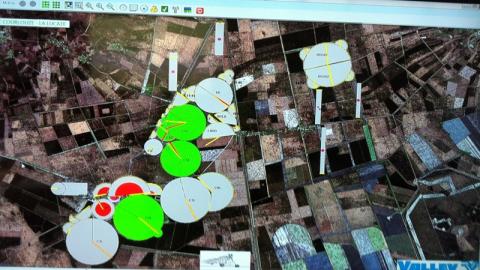On a fine day in early-September, I travelled to the farm of Ludovic Dupouy, a young farmer who grows seed corn (maize) at Rion in the Landes region, near Bordeaux.
I was accompanied by Philippe Bourgoint, Sales & Service Support Specialist at Lindsay Europe.

Mr. Dupouy, an ultra-connected young farmer invited us onto his farm. The farm is divided into three sites: this one, which Mr. Dupouy occupies, and two other sites, located on the border of the departement of Gers, managed by his two partners. “The farm covers 800 hectares in total, of which 400 hectares lie in the Landes”, explained Mr. Dupouy. He only grows seed corn at the Landes site and it is all irrigated with pivots. On the other sites, he has 100 hectares down to seed corn and edible corn. Over in Gers, he irrigates with pivots, but he also uses hose reels because the land is hilly and the fields oddly-shaped.
When Mr. Dupouy took over the farm 6 years ago, the pivots were already there. There are twenty of these machines on the site and almost all of them are computerised. “We had been using another brand’s remote management tool, but we changed over to FieldNET last year”, explained Mr. Dupouy. A FieldNET control Panel was fitted to two pivots of 7 and 8 spans, one of these also being equipped with VRl.
FieldNET by Lindsay is a wireless system that enables the farmer to manage and control his pivots remotely at his convenience. With FieldNET, the farmer can monitor the whole of his irrigation system, pivot by pivot. He can also start and stop his pivots remotely, from a computer, tablet or smartphone, check the status and position of each pivot and receive reports on water consumption.
One of the two pivots was already there when Mr. Dupouy took over the farm. It was equipped with two control boxes, one for the remote management system and the other for the VRI technology.
The aim of the VRI is to apply exactly the right amount of water to the different zones of the field, allowing the farmer to have maximum control over the yields and profitability. Mr. Dupouy has chosen to use it on this field because the soil is very variable, so the water requirements differ from one part of the field to the other. Without VRI, the control box allowed for the field to be divided up into zones (like a camembert cheese), which could be managed stage by stage but the same precipitation rate was applied along the whole length of the machine. With VRI, which incorporates a soil mapping feature, the machine is now capable of recognizing the different zones throughout the field. Everything is set for the farmer to apply the VRI prescription zone by zone.
How the VRI operates
The pivot is equipped with a 3G modem developed by Lindsay Corporation. The VRI control panel supplied with a touch screen communicates with the main control box. The VRI interface also communicates with each of the communication gateways located on the pivot, each communication gateway managing three or four sprinklers individually so as to achieve different irrigation modulations for each sprinkler. Communication is achieved by Wi-Fi from one terminal to the other, because the wifi will not reach as far as the end of the pivot. Mr. Bourgoint starts up the VRI and it can be seen that the amount of water applied varies from one sprinkler to the other (the pivot is equipped with up-top Nelson R3000 Rotator sprinklers). It is also possible to extend the VRI and change to manual mode. In this case, the first control box takes over, using the pivot’s original nozzle package.
“But the VRI is only the last link in the chain”, explains Mr. Bourgoint. “More work is required upstream in order to obtain a soil map of the field showing the different soil types allowing the farmer to apply his or her irrigation prescriptions, zone by zone. It is also possible to use FieldNET ADVISOR, designed and developed by Lindsay Corporation. This is a decision-making support tool completely incorporated into the FieldNET remote management platform, which allows for irrigation prescriptions to be obtained daily, according to the results of the soil mapping, weather data, plant type (corn [maize], soya, Lucerne (Alfalfa), potatoes, sugar cane, etc., its variety and date of sowing or planting. FieldNET ADVISOR with VRI will automatically create the irrigation plans zone by zone, which will be directly implemented by the pivot if the farmer so desires”. The objective of M. Doupuy is to know exactly how much water and fertilisers to apply so as to obtain the best possible yield. Engineers went to the farm in order to carry out very precise soil mapping. The field has been examined with a fine-tooth comb. No less than sixty analyses have been carried out on the 75-hectare field. The soil is sandy as you would expect in the Landes, but the type of sand varies and the aquifer is not at a uniform depth. There is more organic matter in some places than in others. As we can see on the graph (page 7), the blue zones correspond to the zones of the field where the organic matter is deeper and richer and the lighter-coloured zones correspond to the shallower areas with less organic matter. It is more difficult to grow crops in the orange zones and more irrigation is required. In fact, the more sandy the soil, the lower ithe soil’s water retention capacity.
“We then modelled the seeding density for each zone”, explained Mr. Dupouy. The density is higher in the blue zone. “We have pushed the technology to its limit, allowing us to vary the seeding and irrigation rate”, continued Mr. Dupouy.
A review of the last two seasons
When asked: “What has this new installation changed, as far as you are concerned?”, Mr. Dupouy replied: “At first, when the product arrived in the box and I opened it, I was apprehensive. However, it is, in fact, very easy to use”. He added: “I have not had to go out to the pivot since I acquired FieldNET. I have saved on time and used less water”.
This is the second season that the FieldNET technology and VRI have been used on the farm by our farmer. We didn’t save any water during the first season because the summer of 2017 was very hot. “From 12 mm per day we went down to 11 mm. However, during a normal summer we can go down as far as 10. Over 20 circuits, that represents a lot of m3”, explained Mr. Dupouy.
“We did most things manually in 2018. In particular, we varied the seeding rate. Next year, we’ll concentrate more on the water aspect and that’s where the VRI technology will come into its own”, continued Mr. Dupouy.
The farmer always irrigates before sowing the seeds so as to prepare the soil. The seeds are sown over a period of one month, between mid-April and mid-May and harvest will take place over the whole month of September. On the field in question, the corn will be harvested between the 17th and 20th September. Our farmer stops irrigating 10 days beforehand. However, prior of this, Mr. Dupouy has to remove the sensors that are placed around the field. Using sensors is restrictive because they have to be installed and then removed before harvest.
FieldNET Advisor was designed to do without sensors. The plant growth stage models, soil and weather should be enough.
According to Mr. Dupouy, 2018 has been quite a good year for field crops. The harvest was fairly good and prices picked up a little.
The water resource
There is no shortage of water in the Landes. There is a high water table in the subsoil containing non potable ferruginous water. The high iron content of this water makes it very corrosive for the machines. Therefore, the pivot spans have to be replaced regularly, more often than in the other regions. Furthermore, ferruginous water can pose another problem: the hydrovalves and small tubing in the sprinklers can become blocked. To avoid this, the farmer has to rinse through at the beginning and end of the season to remove most of the residues. The installation has been there for two years and so far the filters have not become blocked yet.
Whatever happens, the important thing is that our farmer has all the water he needs at his disposal. “During the summer of 2017, when it was very hot, the water table dropped quite a lot. However, we always had water”, commented Mr. Dupouy. “In the winter, we even had artesian wells”.
To withdraw this water, our farmer had to install a number of boreholes on his farm. “For the sole 8-span pivot alone equipped with VRI, we had to have at least 6 boreholes”, continued Mr. Dupouy.
Conclusion
The VRI is still not very developed at the moment. This investment requires a high value crop to be chosen. Its use can be particularly justified on land with diverse soil types… as in the case of Mr. Dupouy’s farm, or to apply fertilisers to specific parts of the field: or even for pivot-irrigated vegetable crops, in order to irrigate plot by plot, according ito the plant’s needs and its growth stage.


